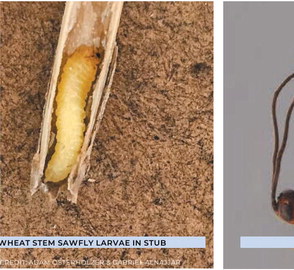Shows Different Grasses More Susceptible Than Others


WHEAT STEM SAWFLY LARVAE IN STUB
COW PEA (BLACK-EYED PEA), POTENTIAL NECTAR SOURCE FOR BENEFICIAL PARASITOIDS
LANDSCAPE SELECTION OF AREAS CONTAINING OVERLAP OF CRP WITH ADJACENT WHEAT CROP MAP Overall, this work suggests that a majority of grass species common in grassland habitats have very low levels of infestation by C. cinctus and, thus, are unlikely to be important reservoirs of either C. cinctus or beneficial parasitoids moving into crops.
That said, wheatgrasses are currently common components of both CRP and roadside plantings in Montana, meaning those grasses could potentially serve as C. cinctus reservoirs, exacerbating pest problems in neighboring cropland. However, Rand also noted that wheatgrass species with high levels of C. cinctus infestation also tended to have the highest levels of parasitism (three times higher
BENEFICIAL PARASITOID
than those in cultivated wheat), suggesting a potential trade-off between reducing pest reservoirs and creating conservation habitat for beneficials.
Providing beneficial insects with alternative hosts in noncrop habitats is a major pillar of habitat management to promote biological control, according to Rand, which makes identifying these alternative resources so important. That said, future work examining the relative performance of pests vs parasitoids in these grasses is also vital to gauging their relative value as plant materials to bolster parasitoid conservation in reseeded grassland habitats, Rand concluded.
Cephus cinctus is a grass-mining sawfly native to North America that moved over from wild grass hosts to cultivated cereals with their expansion following European settlement. Although this pest is widely distributed across North America, economic impacts have historically been restricted to the northern Great Plains, where it has been a problematic pest of wheat for over a century, costing farmers there more than $350 million annually. Over the past decade, however, economic infestations have been increasing across the central Great Plains, and climate models also predict the expansion of economic impacts across its northern range in Canada. A number of parasitoid species attack the sawfly in wild grass hosts, but only the 2two Bracon species have followed their host onto cultivated cereals. Where abundant, these parasitoids are projected to provide important biological control of sawfly populations, significantly reducing the sawfly’s impact on crop yield.
INTERMEDIATE WHEATGRASS, A POTENTIAL REFUGIA FOR PARASITOIDS
IMAGE CREDIT: ADAM OSTERHOLZER & GABRIEL ALNAJJAR






